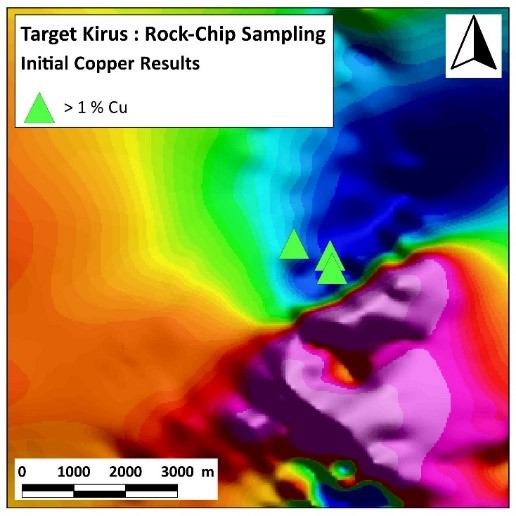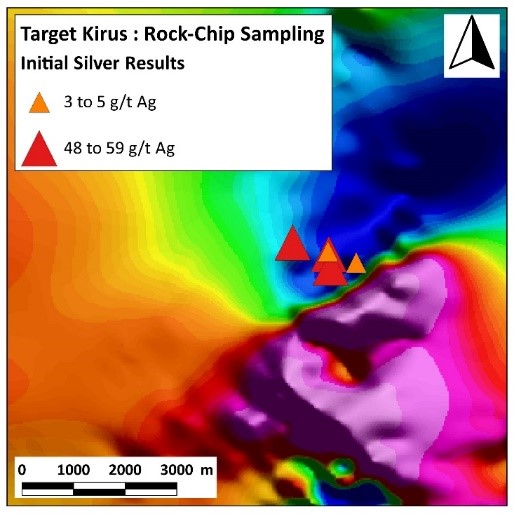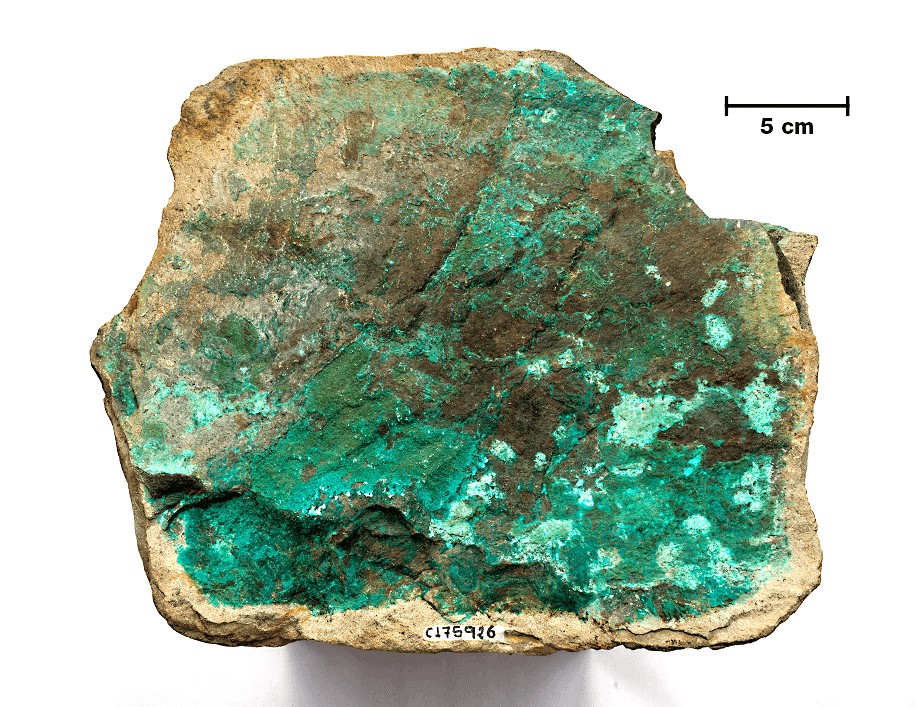Aurania Reports the Discovery of the First Significant Copper Mineralization in the Lost Cities – Cutucu Project
Toronto, Ontario, October 4, 2018 – Aurania Resources Ltd. (TSXV: ARU) (“Aurania” or the “Company”) reports that significant copper mineralization has been discovered by two separate regional exploration teams in the Lost Cities – Cutucu Project (“Project”) in Ecuador. The discoveries are approximately 20 kilometres (14 miles) apart: the first target is called “Jempe” and the other, “Kirus.” The discoveries were made during exploration of two of the many magnetic targets identified from the geophysical survey conducted over the Project.
Aurania Chairman and CEO, Dr. Keith Barron commented, “We are delighted to have linked outcropping copper mineralization with geophysical targets for the first time in our Project area. This gives us confidence that the numerous geophysical features that have been identified as prospective porphyry copper targets in the Project area have real potential.”
Jempe Target:
Copper mineralization has been found in outcropping volcanic rock that was routinely sampled during reconnaissance stream sediment sampling. The samples, which contain conspicuous green malachite and blue-grey chalcocite, returned a maximum value of 3% copper and up to 47g/t silver (Figure 1). This copper mineralization is significant because it:
- Occurs in an area of weak magnetism (defined in data from the geophysical survey that was flown last year); and
- Occurs in tuff (hardened volcanic ash) that is typically deposited above, or lateral to, the copper-rich core of porphyry systems.
These features, along with the low molybdenum content of the tuff, suggests that the copper mineralization found at Jempe does not lie in the core of the mineralized system: the core is likely to be associated with either or both areas of strong magnetism that flank the magnetic low evident in the geophysical data (Figure 2A).
Kirus Target:
Final assays have not yet been received from routine rock-chip sampling that was done during the stream sediment sampling of the Kirus geophysical target. However, initial results show in excess of 1% copper and up to 59g/t silver – final copper results will be reported when they are received from the lab. As with the Jempe target, the host rock to the copper-silver mineralization at Kirus is finely banded tuff (Figure 3).
The copper mineralization encountered in the first reconnaissance of Kirus lies on the northern edge of an area of anomalously strong magnetism that is approximately 4 km in diameter (Figure 2B and 2C).
Figure 1. Copper mineralization (2.97 % Cu, green is malachite – a copper carbonate mineral) in sandy-textured tuff from the Jempe target. The black layers are secondary biotite alteration of hornblende crystals. Biotite alteration is typical of porphyry systems.
Figure 2. Map showing the magnetic feature in the geophysical data from the Jempe (A.) and Kirus (B. & C.) targets. The colour range on the map is dark blue for the areas of weakest magnetism through to pink for the most highly magnetic areas. The location of the rock chip samples is also shown.
Aurania’s President, Dr. Richard Spencer, noted, “I was involved with the initial discoveries of the San Carlos, Panantza and Mirador copper porphyry deposits in Ecuador that are currently being developed. The discovery of this initial copper mineralization at surface at Kirus and Jempe on Aurania’s property approximately 25 kilometres to the north of San Carlos and Panantza and approximately 75 km to the north of Mirador, is more impressive in the samples taken to date. It is also important to note that our copper mineralization occurs in tuffaceous rocks versus the occurrence in granitic rocks at San Carlos, Panantza and Mirador. This would suggest that we may have the full porphyry system preserved with little to none eroded off.”
The geophysical signature of the Kirus target is similar to that of porphyry systems elsewhere in the world where copper mineralization is concentrated near the magnetic core of granitic bodies. Most porphyry systems have characteristic alteration zoning from magnetite-biotite at the core – formed under the highest temperature – through concentric bands of lower-temperature minerals that form further from the core. Three features of the rock-chip samples from Kirus suggest that they are from the outer parts of a porphyry system:
- The pervasive alteration mineral is white clay – suspected to be illite-smectite – that forms in the outer and upper periphery of porphyry systems. It is unusual to have high-grade copper so far from the core of a copper porphyry;
- The host rock is a volcanic tuff – again, typically found outward of the core of porphyry systems that are usually centered on intrusive stocks of broadly granitic composition; and
- The molybdenum values of the rock chip samples are relatively low in comparison to porphyry copper deposits such as Mirador, San Carlos and Panantza that lie along-trend in the Cordillera del Condor. Molybdenum is concentrated in the core of those deposits.
The conclusion of this early-stage work is that both the Kirus and Jempe targets represent the upper parts of porphyry systems, and the porphyries are expected to lie at relatively shallow depth beneath, and lateral to, the reconnaissance sample positions.
Figure 3. Copper mineralization (green is malachite – a copper carbonate mineral) in tuff from the Kirus target.
Next Steps:
The plan is to complete the stream sediment sampling program over the geophysical targets and to cover the catchment areas that are enriched in copper and associated metals, with ridge and spur soil sampling to refine the location and shape of the target. It is anticipated that Jempe and Kuris will join the list of targets being ranked for near-term scout drilling.
Neither the TSX Venture Exchange nor its Regulation Services Provider (as that term is defined in the policies of the TSX Venture Exchange) accepts responsibility for the adequacy or accuracy of this release.
Forward-Looking Statements
This news release may contain forward-looking information that involves substantial known and unknown risks and uncertainties, most of which are beyond the control of Aurania. Forward-looking statements include estimates and statements that describe Aurania’s future plans, objectives or goals, including words to the effect that Aurania or its management expects a stated condition or result to occur. Forward-looking statements may be identified by such terms as “believes”, “anticipates”, “expects”, “estimates”, “may”, “could”, “would”, “will”, or “plan”. Since forward-looking statements are based on assumptions and address future events and conditions, by their very nature they involve inherent risks and uncertainties. Although these statements are based on information currently available to Aurania, Aurania provides no assurance that actual results will meet management’s expectations. Risks, uncertainties and other factors involved with forward-looking information could cause actual events, results, performance, prospects and opportunities to differ materially from those expressed or implied by such forward-looking information. Forward looking information in this news release includes, but is not limited to, Aurania’s objectives, goals or future plans, statements, exploration results, potential mineralization, the corporation’s portfolio, treasury, management team and enhanced capital markets profile, the estimation of mineral resources, exploration and mine development plans, timing of the commencement of operations and estimates of market conditions. Factors that could cause actual results to differ materially from such forward-looking information include, but are not limited to, failure to identify mineral resources, failure to convert estimated mineral resources to reserves, the inability to complete a feasibility study which recommends a production decision, the preliminary nature of metallurgical test results, delays in obtaining or failures to obtain required governmental, regulatory, environmental or other project approvals, political risks, inability to fulfill the duty to accommodate indigenous peoples, uncertainties relating to the availability and costs of financing needed in the future, changes in equity markets, inflation, changes in exchange rates, fluctuations in commodity prices, delays in the development of projects, capital and operating costs varying significantly from estimates and the other risks involved in the mineral exploration and development industry, and those risks set out in Aurania’s public documents filed on SEDAR. Although Aurania believes that the assumptions and factors used in preparing the forward-looking information in this news release are reasonable, undue reliance should not be placed on such information, which only applies as of the date of this news release, and no assurance can be given that such events will occur in the disclosed time frames or at all. Aurania disclaims any intention or obligation to update or revise any forward-looking information, whether as a result of new information, future events or otherwise, other than as required by law.








